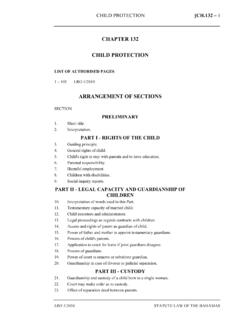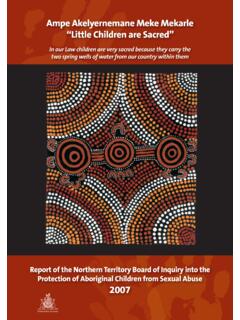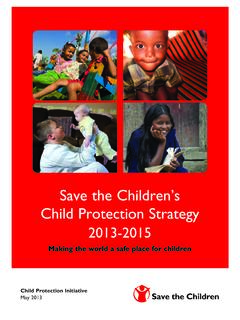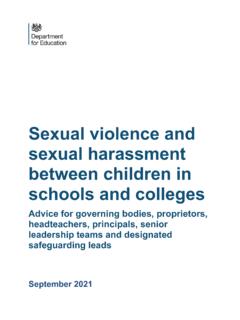Transcription of Help, protection, education: concluding the Children in …
1 Help, protection , education: concluding the Children in Need review June 2019 2 Contents Secretary of State Foreword 4 1. Introduction 6 Who are Children in Need ? 6 What we ve done 7 Key findings from our data and analysis 8 A summary of our conclusions 9 Children s social care support 9 Support in and around schools 10 Areas for action 12 2. Visibility 13 National focus 13 Information sharing 14 3. Keeping Children in education 17 Absence 17 Moving between and out of school 18 Exclusions and alternative provision 19 4. Aspiration 21 Leadership and partnerships 22 Roles between schools and social care 23 5. Support in and around schools 25 What works 25 Recognising and responding to Children s needs 26 Co-ordinating support in school 28 6. Supporting families and communities 30 Support for families 30 Support in the early years 31 Support for Children and young people s mental health 33 Support for adolescents 34 7.
2 Conclusion 36 A call to action: 36 To increase visibility and recognition of these Children in education, we will: 36 3 To keep Children in education, so that they benefit from the safety and security that this can offer, we will: 37 To raise aspiration for Children to realise their potential, we will: 37 To ensure that Children receive effective, evidence-based support in and around school, we will: 37 In continuing to build the evidence base, we will: 38 Thank you: 38 4 Secretary of State Foreword Every child deserves the chance to fulfil their potential and achieve the best educational outcomes possible, whatever their background, whatever their path. Yet adversity in childhood diminishes that chance, putting at a disadvantage those who have needed Children s social care to provide them with help and protection .
3 Tireless work by social workers, school staff and others has long been motivated by supporting these Children , knowing what it takes to help them succeed. But the Children in Need review is the first time that we have evidenced this. In doing so, the focus and clarity of the review has uncovered how gaps in attainment come about for these Children , and in learning from best practice happening already, what we must do to overcome them. From the day-to-day reality on the frontline, we now know that nationally at least million Children have needed a social worker at some point, equivalent to 1 in 10 Children last year. The large majority are not in care, but facing adversity in families, lacking the safety and stability that most take for granted. The impact on attainment for Children who currently need this help and protection is more severe than coming from a low-income background.
4 It should concern all of us that there is such a significant additional impact on educational outcomes, and that these poor outcomes last, even after social work involvement has ended risking a lifetime toll on employment, health, and social participation. But most of all, it must galvanise us to action, sustaining our Manifesto commitment to deliver the review, by doing more to transform these outcomes. This will always require services beyond schools to prevent and address why Children are in need, promoting safety and stability through social care. Without this, schools too often find themselves with no choice but to try and support as best they can, the vulnerable pupils they see each day supporting Children in ways far beyond their purpose in providing an education. Our social care reforms already underway are about driving up the quality of local authority services, developing a highly capable, skilled workforce, and investing in strengthening families.
5 We still have further to go. Tackling the drivers of need must be a common endeavour across Government, not an ask of schools. Findings from the review will not fall into this trap, where I am determined that Children should get the right help through every agency playing their part, sharing their expertise, and working together. Most commonly, Children are affected by the problems their parents experience domestic abuse , substance misuse, mental ill health but this also increases Children s own vulnerability as they reach adolescence. We therefore need social care, health, police, youth services and more, that are resourced and able to prevent and resolve causes, and support Children and families acting early, together with schools, to break the cycle of disadvantage. 5 Towards achieving this, the Children in Need review set out to understand what more can make a difference in education.
6 Learning from those with expertise, our evidence through the review leads us to where renewed action by Government should start: promoting visibility and recognition, not only for the purposes of safeguarding but in education; keeping Children in school, making sure that this is a protective factor against abuse , neglect and exploitation; raising aspiration to expect more and better for these Children , in the belief that they can succeed; and, finally, supporting schools to support Children themselves recognising how far adversity in childhood has lasting consequences for attendance, learning, behaviour, and mental health. Undeterred by these barriers, schools that I have visited are doing incredible work to help Children succeed against the odds. I have been struck by the dedication of school leaders and staff in making sure that education makes a positive difference to every child s life chances.
7 That commitment is unwavering and ambition for Children uncompromised, in spite of the pressures that I recognise schools and social care are facing. The role of schools is in educating Children , but I have seen how far they are going above and beyond this, in order that Children are attending each day, ready to learn, and able to benefit from the best that our schools can offer. Our aim is that action following this review alongside the Government s response to the Timpson Review of School Exclusions should contribute to cracking some of the systemic challenges to supporting vulnerable Children . That means supporting better information sharing, improving partnerships with local authorities, strengthening co-ordination of support, and working with schools to build and share the evidence of what interventions are most effective in improving these Children s outcomes.
8 Whilst the review has reached its conclusion, it has only strengthened my commitment to end the injustice of these Children s poor outcomes. Already at the heart of keeping Children safe, now when we look to the future of education and educational disadvantage in particular these Children must be at the forefront of action here too. We all need to work together, as a priority, to make this happen; this is only the start. Rt Hon. Damian Hinds MP Secretary of State for Education 6 1. Introduction Everybody needs an education [..] I just want to learn (young person) Our ambition for Children in Need of help and protection is the same as for any other child: that they should be safe and have the opportunity to succeed. Those who have faced adversity, trauma, or are disabled may face barriers in education, but this cannot be allowed to stop any child from realising their potential.
9 In support of this, the purpose of the Government s reforms to Children s social care has long been to improve safety and stability for all of these Children . In recent years, there has also been concerted action to promote the educational outcomes of Looked After Children and care leavers, for whom the state is a corporate parent. Yet there remained a larger group, still needing social care support but at home with their parents, whose educational outcomes had historically lacked the same attention and focus. In building the evidence around this, the Children in Need review has transformed our understanding of these Children for the first time, shining a light on their experiences, the impact this has on educational outcomes, and what makes a difference to improving these. Our interim findings, published in December 2018, set out what is needed, and a guide for how Children can be best supported.
10 Our conclusion now sets out the aims that we, as Government, commit to pursue in support of making this happen, as well as further findings to act on now. Across four areas of action, we will catalyse change in the near term. Whilst bringing the review to an end, this sets the direction for what is only the beginning of what must be continued long-term efforts together with schools, social care, health, police and more if we are to make a meaningful difference. Our evidence has come from seeing what works in some of the places that some Children are doing well, compared to others. Whilst we found no single way of achieving this and differences in approaches, nevertheless there were some common features in what worked well. Learning from this, future action aims to bring more Children , more local authority social care services, and more schools closer to the best performing and achieve greater consistency in doing so, closing disadvantage gaps and raising standards for all.
















